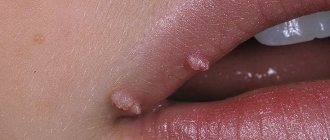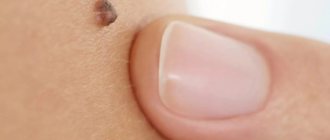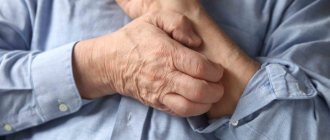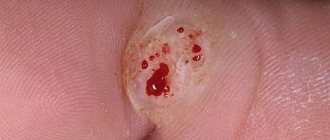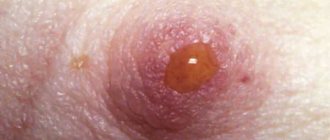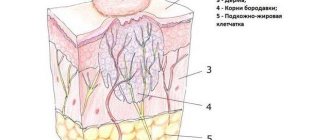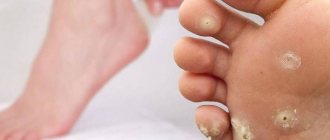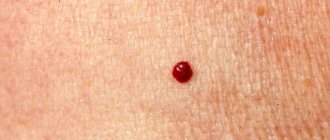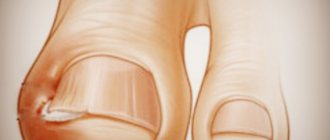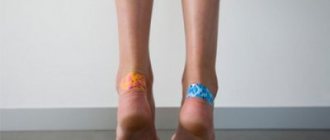Chicken ass: what is it?
Plantar growths or spines are popularly called chicken butts. This is one of the most common types of neoplasms of viral etymology. Chicken ass on the leg is a benign formation with a low risk of malignancy. However, rubbing with shoes can lead to the transformation of growth cells into an oncological tumor.
Prevention of the formation of plantar acrochords
The basis for preventing chicken butt plantar warts is personal hygiene. Never walk barefoot, especially in public bathrooms, locker rooms, and bathhouses. In crowded places, you must be provided with special shoes (the staff should always have slippers for the pool or sauna). You should avoid direct contact with unprotected and possibly contaminated surfaces as much as possible.
Don't share or wear clothes of strangers. If any part of your body that is infected with HPV touches your clothing, you will definitely become infected if you come into contact with it. Personal items that may come into contact with the virus (socks, towels, underwear) should be washed in hot water with plenty of soap. This way you can avoid spreading the chicken ass and prevent infecting other people.
Appearance
Most often, wart growths appear on the lower extremities: on the toes, between them, on the sole or heel. Initially, a yellowish smooth spot appears on the foot, which over time becomes covered with scales and becomes brown. Chicken butt between the toes is often mistaken for a dry callus. This is due to the keratinized outer layer covering the wart. It consists of dead cells of the upper layer of the epithelium - the dermis. A chicken butt does not have “legs”; its roots grow deep, so it is quite difficult to remove such a growth.
If you thoroughly steam the foot and use a pumice stone or a foot file to remove the keratinized top layer of the wart, dark spots become noticeable. These are clotted small vessels - capillaries.
Chicken wart resembles an iceberg. The part located on the surface makes up a small fraction of the entire neoplasm. Most of the roots grow in depth and can be several times larger than the “top” in size.
Causes
The main cause of any wart is infection with papillomavirus (HPV). The main route of infection is through household contact. HPV infection can occur:
- In close contact with its carrier;
- Due to violation of hygiene rules (wearing someone else's shoes, trying on without a sock, using someone else's bath accessories, visiting the pool without rubber slides).
Increase the risk of infection:
- Sweaty feet;
- Dry, cracked skin on the feet;
- Lack of foot hygiene;
- Deformation of the foot (appearance of a bone, curvature of the fingers, especially the little finger, flat feet);
- Wearing tight, small or uncomfortable shoes;
- Wounds or microcracks on the skin of the foot;
- Concomitant chronic diseases (diabetes mellitus, atherosclerosis, varicose veins).
A distinctive feature of HPV is its long incubation period. As long as the human body is able to provide an immune response to the attack of the virus, HPV is in “hibernation.” Its activation is facilitated by a weakening of the immune defense or its switching to another “enemy”.
Therefore, the appearance of chicken growths is an alarm bell! This is a signal of weakened immunity.
Symptoms
The formation of a chicken butt goes through a number of stages:
- The appearance of a smooth spot on the sole or toe;
- The appearance of scales;
- Formation of a dense spherical nodule with clear boundaries and a keratinized surface;
- The growth grows up to two centimeters in diameter;
- The appearance of pain when walking.
Must read Wart on toe
Discomfort, and then pain, is associated with the location and deep roots of chicken growths. As the wart roots grow, they compress the nerve endings. This leads to pain when walking. Over time, the pain syndrome intensifies, turning a person into a disabled person, unable to move independently.
What acrochords look like, symptoms
Diagnosing chicken butt is not difficult, since a person can independently notice and identify the pathology. Signs of plantar warts:
- roughening of the skin. The top layer on the surface of the foot becomes denser, and specific rashes form (very similar to small subcutaneous pimples);
- dryness. The epithelium dries out, begins to crack, and bleeding black spots (thrombosed capillaries) form;
- pain syndrome. The patient feels pain and discomfort when walking and pressing on the limb. If calluses provoke pain only with direct pressure, then papillomas cause discomfort with direct impact, compression, pressure;
- yellow tint. The chicken ass itself and the area around it turn yellow, which also helps to independently diagnose the presence of the HPV virus;
- specific location of formation. Chicken butts prefer points of greatest pressure: heels, toes, balls of the feet;
- DNA change. HPV penetrates DNA and tries to change its structure. As a result, we get a papillary pattern on the skin (relief lines on the stratum corneum) and further formation of warts in the upper layer.
After detecting symptoms of the formation of a chicken butt wart, consult a dermatologist. Try to protect the acrochord from contact with shoes, which could damage it, so as not to provoke its further growth. Before undergoing diagnosis, it is necessary to strengthen hygiene measures, wash clothes in hot water with plenty of soap and protect the affected limb from contact with household items as much as possible in order to prevent HPV from spreading and infecting household members.
The danger of chicken wart on the leg
Strains of papillomavirus that cause the appearance of plantar growths are not oncogenic. However, the risk of malignancy of the tumor remains. Transformation of a growth from benign to oncological can occur due to:
- Constant rubbing of calluses with shoes;
- An unsuccessful attempt to get rid of the formation by cutting it off with a knife;
- Unintentional injury to the wart.
To prevent the tumor from degenerating into a cancerous tumor, the wart should be removed as soon as possible.
How to cure chicken callus
Therapy for chicken warts, like other types of tumors caused by papillomavirus, is a complex undertaking. It includes getting rid of the growth, taking antiviral drugs and strengthening the immune system.
It is best that the treatment regimen is prescribed by a doctor. He will confirm the diagnosis, prescribe the most appropriate medications, taking into account the course of the disease, a history of chronic diseases, allergic reactions and other physiological characteristics of the patient.
You can try to cure chicken ass yourself using pharmaceutical preparations or folk remedies. But you should be patient, such treatment is usually long and less effective than radical methods of traditional medicine. You should not treat warts at home in children or people suffering from chronic diseases such as diabetes. Atherosclerosis or varicose veins.
Specialized clinics
The easiest way to cure a chicken wart is to go to a medical center. Qualified doctors can quickly and painlessly remove unwanted growth using one of the radical methods:
- Laser destruction . One of the most effective methods of getting rid of chicken growths. The laser beam, acting precisely on the tumor, evaporates its tissue layer by layer. The remaining small depression heals on its own within seven to ten days;
- Radio wave removal . The newest non-contact method of influencing the growth, using radio waves of various frequencies. The advantage of the method is to prevent the spread of HPV, due to coagulation of capillaries, and there is no risk of developing a secondary infection;
- Cryodestruction . Chicken callus can be treated not only by cauterization, but also by freezing its tissues. Liquid nitrogen, cooled to minimum temperatures, leads to necrosis of wart tissue. The skin first turns white, then turns red. A blister forms at the site of the removed growth, which resolves on its own within a week. The disadvantage of this method is the inability to assess the depth of nitrogen exposure. Therefore, several procedures may be needed to achieve results;
- Electrocoagulation . Burning out a tumor with a high-frequency current closed in a loop. Dried blood and lymph form a natural dressing over the wound, protecting against the entry of pathogens. Not suitable for old formations with deep roots;
- Surgery . The surgeon removes the growth with a scalpel. The technique is recommended only for large tumors or in cases of suspected malignancy. The most traumatic procedure requiring the use of local anesthesia. A scar remains at the site of the excised growth.
Must read: Removing flat warts on the face
The doctor will advise which method of wart removal to choose, taking into account the characteristics of the body, the wishes and financial capabilities of the patient.
Methods of treating chicken zholka
The causative agent of the pathology is widespread. More than 50% of the world's population is infected with the papilloma virus. However, the diseases caused by it occur only in a small proportion of infected people. HPV is considered the direct cause of the development of chicken gall. However, other factors also influence the formation of the tumor. These include:
- The presence of cracks on the surface of the sole;
- Chronic pathologies of the vascular system, in particular diabetes mellitus;
- Wearing uncomfortable shoes;
- Decreased immune defense.
Damages on the surface of the epidermis are entry points for viral agents. Common skin disorders include ulcerative defects (diabetes mellitus, phlebitis, arteritis) and cracks. The human papillomavirus causes warts when a person has a weakened immune system.
Cracked heels are an open gate for viruses
Calluses on the foot are formed due to friction of the skin against rough and tight shoes. Damage to tissue can lead to the penetration of infectious agents, in particular HPV types 1,2 or 4. If the disease has already begun to develop, the callus only aggravates the course of the pathological process. It leads to expansion of the affected area and roughening of the skin at the site of the defect. A specialist will tell you how to cure a chicken callus on your leg. To do this, you should consult a surgeon.
After conducting examinations and examining the foot, the surgeon decides what methods to treat the chicken callus. Methods for removing tumors include:
- Wart removal;
- Drug therapy;
- Traditional methods.
Surgery will help completely remove the chicken gall. However, it has several disadvantages. Among them: the risk of infection of the body, the formation of scarring on the sole. Surgical treatment is carried out only in cases where the tumor reaches a large size and it is impossible to remove it in any other way.
The operation is performed in an inpatient (less often outpatient) setting under local anesthesia. Traditional surgery is performed using a scalpel. After excision of the skin and determination of the depth at which the roots of the callus are located, the formation is completely excised. This is accompanied by stitching or coagulation of bleeding vessels. The wound surface is washed with disinfectant solutions. Dressings are performed for several days after the operation.
Laser removal
It is up to the surgeon to choose how to treat chicken callus. This depends on the depth of the wart and its size. An effective way to remove chicken callus is laser excision of the callus. Using a coagulator, layer-by-layer radiation is applied to the cells of the pathological formation. Thanks to the laser, it is possible to cause layer-by-layer destruction of the wart. The advantage of this method is the simultaneous coagulation of bleeding vessels.
Cryodestruction
Removing callus using liquid nitrogen is called cryodestruction. This method is widely used in practice in the presence of “fresh” tumors. The advantage of the procedure is that liquid nitrogen not only leads to the destruction of callus cells, but also destroys viral particles. After cryodestruction, a bubble filled with serous content remains on the surface of the skin, which cannot be opened due to the risk of infection. The defect site is treated with salicylic alcohol for several days.
Electrocoagulation
The electrocoagulation method is characterized by the destructive effect of current on callus tissue. This method is reminiscent of surgical treatment, since a scalpel is used as an instrument. The difference is that destruction occurs due to the effect of electric current on certain points. The high temperature of the blade allows the blood vessels to coagulate.
Before resorting to removal of the formation, treatment of chicken callus at home is prescribed. For this purpose, patches and ointments are used. These medications are impregnated with salicytic acid, which has keratolytic properties (destroys callous skin). Some patches also contain other substances, for example, a propolis solution. They soften dead skin and help reduce pain. These medications include the Salipod patch.
You can remove calluses using ointments. They are created on the basis of salicylic, lactic or nitric acid. Their mechanism of action is the same as that of patches. Use 3% oxolinic and 2% salicylic ointment.
Therapeutic methods also include those that have been used by people for a long time. Celandine juice, table vinegar, lemon zest, etc. are used. You need to know the rules on how to treat chicken jowl callus with folk remedies. To avoid damaging healthy skin, cover the area around the wart with an adhesive plaster.
Chicken butt occurs due to infection with human papillomavirus (HPV) types 1, 2, 4, 27 or 57. These types of HPV are not oncogenic and do not cause malignant pathologies.
Infection with the virus usually occurs in public locker rooms, swimming pools, and resorts. A person who already has chicken callus is a source of HPV and, when walking barefoot, creates conditions for infecting others. Infection can even occur while visiting or in the fitting room of a shoe store if you come across a pair of shoes that were previously tried on by a sick person.
We suggest you read: How to treat warts on a child’s foot
Note! Always take a change of shoes with you to the resort or to the pool, and when going for a new pair of shoes, try on socks. This will help avoid infection not only with plantar papilloma, but also with foot fungus.
Electrocoagulation
Drug therapy
For adherents of conservative treatment, pharmaceutical companies offer a wide selection of medications. You can buy them at any pharmacy without a prescription. However, given that such drugs contain aggressive alkalis or acids, it is better to consult a doctor before use.
Principles of using medications:
- Complex treatment is the key to success. Therapy that combines removal of the growth with the use of antiviral and immunostimulating drugs is the fastest way to get rid of them forever;
- Strict adherence to the instructions drawn up by the manufacturer will protect you from unwanted consequences;
- A thick cream or adhesive plaster will help protect the healthy skin around the wart from chemical burns.
The basis of drug therapy is antiviral drugs: Acyclovir, Imiquimod. Destroying HPV at the cellular level in most cases leads to the disappearance of warts.
If the growths remain, you can remove them at home using medications. They are available in the form of an ointment, solution, cream or patch. The most effective are:
- Verrucacid;
- Super clean;
- Feresol;
- Lapis pencil;
- Salipod.
To enhance the effect, before using these drugs, it is recommended to steam the damaged area of skin in a hot bath with sea salt and soda. This way, the active substance will quickly reach the source of infection, removing not only the surface layer, but also the root of the chicken ass.
Immunomodulators - Imiquimod, Viferon promote the production of their own interferon. This substance is produced by the body of a healthy person in response to a viral attack. They accelerate the destruction of papillomavirus cells and strengthen the body's defenses, reducing the risk of recurrence of tumors.
Overview of removal methods
Chicken butt on the leg and other parts of the body brings a feeling of discomfort and pain, doctors advise getting rid of it. Treatment of the formation must be comprehensive, it is prescribed by a dermatologist. Depending on the type of growth, its size and shape, the doctor uses the following methods of therapy:
- Pharmacy drugs. Dermatologists prescribe antiviral drugs (Acyclovir or Imiquimod) to the patient. In people with strong immunity, the formations disappear after taking them or treating the growth.
- Contact cauterization of the growth with medications. These include patches, ointments, solutions based on celandine (Frezol, Lapis pencil, Super celandine, Verrucatsid). The products must be used carefully so as not to burn nearby healthy skin.
- Therapy at home using traditional methods. Apply celandine juice to the sore spot twice a day until the growth disappears. Garlic is also suitable for treating chicken butt at home; for this, one clove is cut in half lengthwise and the cut side is applied to the spine, covered with a plaster, and left for a day. The course of therapy is four weeks.
If methods are powerless against chicken butt callus, the dermatologist advises removing it in the hospital using minimally invasive techniques or surgery. You can remove education using the following methods:
- Laser therapy. The callus is removed layer by layer with a special apparatus, the patient does not feel pain, and there are no scars left after the procedure.
- Diathermoelectrocoagulation. After manipulation, a crust remains in its place, which falls off without leaving scars.
- Cryodestruction. The growth is cauterized with liquid nitrogen; there is a danger of touching healthy tissue. A sore forms at the site of the operation, which cannot be removed independently; it gradually falls off, leaving clean and healed skin at the site of the growth.
- Radio waves. The operation is performed with a radio knife and there is no risk of infection or bleeding. The rehabilitation period is short.
- Surgical excision. The wart is removed with a scalpel. The method is used only for extensive growths on the skin.
We suggest you familiarize yourself with White pigment spots in children
Eliminating plantar warts is quite difficult at home; pharmaceutical drugs do not always cope with them. If you suspect the formation of a spine on the body, you should visit a dermatologist who will select the optimal treatment method.
Folk remedies
You can remove chicken ass with the help of recipes from folk healers. Perhaps some of them will not inspire confidence in you, but their effectiveness is confirmed by reviews of patients who have tried the treatment on themselves. Harmlessness, accessibility, and the ability to carry out treatment without leaving home are the main advantages of therapy using folk remedies.
Must read Pharmacy remedies for warts
Celandine
The cauterizing properties of this plant gave it a second, popular name - warthog. The juice from the stem of picked celandine is an excellent remedy for getting rid of chicken ass. But such treatment will be effective only during the flowering period of the plant: from the beginning of May to the end of June. At other times, you can purchase Mountain Celandine at the pharmacy, which contains an extract of medicinal herbs.
A small amount of celandine juice or extract is used to treat the neoplasm two to three times a day until it disappears completely. The average course of treatment is three to four weeks.
Garlic
If you have the flu or a cold, eat more garlic. If garlic copes with such viral infections, it can also be used against HPV.
To do this, the peeled garlic clove is crushed using a garlic press, grater or knife. The resulting slurry is spread on cling film or parchment. The resulting compress is wrapped around the previously steamed affected area of skin and secured with a bandage or plaster. Leave until morning. Repeat the manipulation for two to three weeks until the growth completely disappears.
Vinegar
A household product such as vinegar can be found in any housewife’s kitchen. To remove plantar growths, you only need a few drops of ordinary table vinegar. Gently apply vinegar to the new growth, avoiding contact with healthy skin. Repeat three times a day for two to three weeks.
Propolis
Take a small piece of propolis and mash it. Cover the wart with the resulting mixture. Secure with adhesive tape. The propolis compress should be worn without removing for two weeks. After taking a bath, replace with a new one. After two weeks, remove the propolis cake, clean the top layer of the growth and apply a new compress.
Usually, to completely get rid of a chicken ass, you will need three to four procedures. The course of treatment will take from one to two months.
Treatment of plantar warts with garlic
“Chicken ass”, the treatment of which can be both traditional and non-traditional, must be eliminated using the following methods:
- Removal with liquid nitrogen.
- Elimination of warts with laser.
- Chemical methods for removing tumors.
- Application of electrocoagulation.
- Surgical intervention (removal of the wart with a scalpel).
- Unconventional methods of treatment.
In this case, the neoplasm is cauterized using a special electrical device. This procedure must be done under local anesthesia. Some time after electrocoagulation, the sore spot turns black, but heals quite quickly. In this case, the plantar wart is removed along with the root, but a small scar may still remain.
Everyone knows that this plant kills viruses, and some people are even confident that it can also eliminate the papilloma virus in the human body. The recipe for getting rid of the spine is as follows:
- The wart needs to be steamed in clean, boiled hot water. Then you should partially cut off the formation with nail scissors, which must first be treated with alcohol. In this case, it is necessary to cut off the skin roll and a little of the “chicken ass” tissue itself.
- Peel the garlic, separate 1 clove, wash it, cut it in half and place it on top of the wart.
- Use an adhesive plaster to secure the plant to the spine. Leave your foot in this state overnight. Repeat everything in the morning. The duration of such treatment is 2–4 weeks. For quick results, you should do these garlic patches 2 times a day and do this constantly. However, if this is not possible (a person works, for example, and does not want to smell like garlic), you can at least do this procedure in the evening and throughout the night.
Prevention of relapse
It will not be possible to cure papillomavirus completely, but you can avoid the reappearance of defects on the skin.
To do this you need:
- Maintain foot hygiene;
- Do not use other people's hygiene products;
- Try on shoes with socks on;
- Wear comfortable leather shoes;
- Moisturize the skin of your feet with a nourishing cream.
These simple measures will protect your legs from repeated manifestations of papillomavirus, and chicken warts will forever be a thing of the past.

